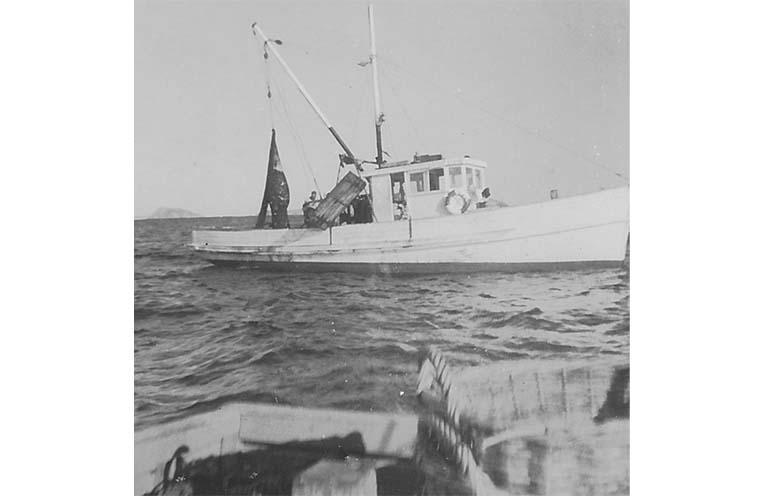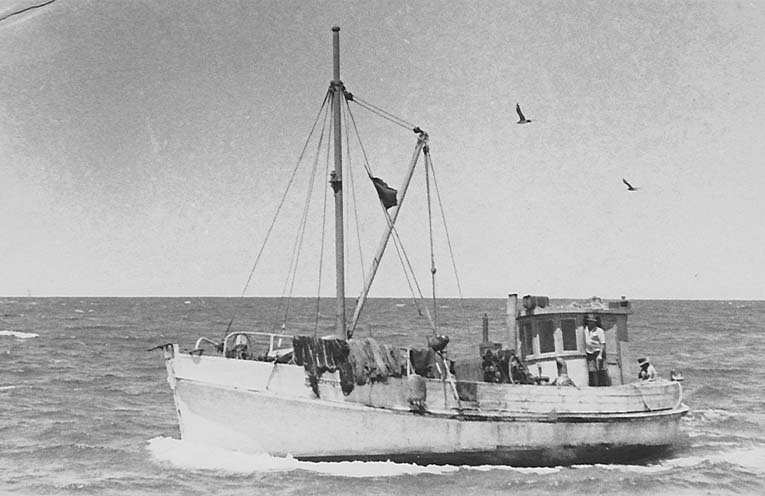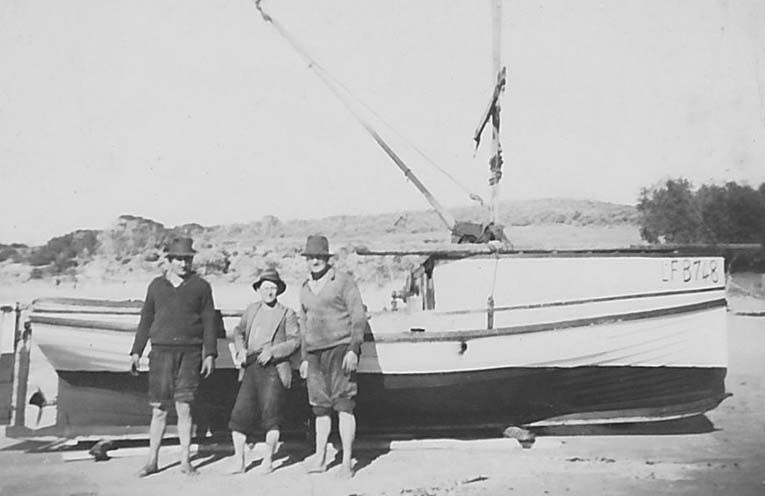
THIS story is part four of a series about the Mitchells, an early Port Stephens fishing family.
FOR me, writing the history of the commercial fishing industry in Port Stephens was a challenge that took over three years to complete.
During those three years I was to meet some of the most interesting people I have ever met.
Every fishing family had a story to tell.
None more fascinating than the Mitchells.
Picking up from last week, Colin Mitchell continues to recall his experiences.
“Back to work, this time set-lining for shark liver,” he said.
“There was a ban on cod liver oil coming into the country at the time so there was good money to be made – three dime per pound for the liver delivered to Sydney.
“One big tiger shark we caught was 25 feet long and his liver filled a 44 gallon drum.
“When we cut the shark open it had an entire porpoise inside.”
Trawling in ‘Girl Pat’ with his dad, Colin said the only fish with any value were flathead, gummy shark, snapper and jew.
“It was quite common for us to get a shot of John Dory and undo the cod end string and let them all go, maybe 50 – 60 boxes, all dead,” Colin said.
“They would be all full of air and the sharks would have a picnic on them.”
In the Stockton Bight in the 1950s, Colin said prawns were “as thick as fleas on a dog’s back”.
“We could trawl 25, 80lb boxes almost every day for about four months in the summer.”
The prawns were packed in kerosene cases lined with newspaper to stop them from falling through the cracks, iced and then sent to Sydney.
“For our efforts we were paid 3d/lb, which was very good,” Colin said.
“Dad and uncle reckoned they could make more if the prawns were cooked, so they got a diesel-fed boiler made out at Gonninan’s workshops, two tonnes weight all lined with fire bricks.
“You can imagine that the boiler was very heavy; we had to get a Brambles crane down to lift it on board the ‘Eileen Sylvia’ and set it right in the middle of the boat.”
A 12 gallon drum of diesel was set up on the wheel house roof to fuel the boiler.
Colin Tarrant showed the Mitchells how to cook the prawns, as he had experience doing so in the Myall Lakes.
The Mitchells would now tow a 16-foot dinghy behind ‘Girl Pat’.
As they would pass the ‘Eileen Sylvia’, Colin would row over with five or six baskets of prawns for the crew to cook. “This would go on until 1-2pm in the day ‘til all our prawns, on both boats, were cooked.
“Then we would go into Newcastle Harbour and tie up.
“The first of the big buyers to show interest in our cooked prawns was ‘Red Funnel Fisheries’ and he took 25 boxes for a sample at the fantastic price of 1/- per pound.”
The next day Red Funnel raised the price to 1/3/lb.
“What a scramble after that,” Colin said.
“Everyone [was] making cookers out of everything and anything.”
Later, the Eileen Sylvia and Girl Pat left Port Stephens and were steaming towards Stockton when they came on a sailing boat that was beached on the Fingal Spit, a finger of sand that connects the island to the mainland.
The yacht had attempted to sail through the spit on its way to the entrance to the port.
Brian Hall, who was out for a day on the water with the Mitchells, swam ashore from Eileen Sylvia with a rope and helped them bail out.
Alf and Colin, on board Girl Pat, were called in to assist and both trawlers were able to pull the sailboat off the beach. The lone sailor continued his travels and entered the port and went over to Tea Gardens to repair any damage.
Once repaired he came back to Nelson Bay where he tossed out the anchor.
When the Mitchells were short of a deckhand or one of the brothers were unable to go to sea, the sailor was picked up to work on the trawlers.
The Mitchells went to Queensland at this stage, and in their absence the sailor, Sam, bought an old trawler and began living on it at Salamander Bay.
While in Queensland the Mitchells were told that a policeman was crossing the Hunter River on the punt at Stockton when he shot himself in the backside with his own gun.
The story goes that the policeman was on his way to Nelson Bay to arrest the sailor, Sam Luxford, an alias, for bank robbery.
The alleged bank robber was finally arrested and returned to Melbourne where he ended up in jail.
He never did forget the assistance given to him by the Nelson Bay fishermen and regularly wrote to them during the early 1960s from his cell in ‘B’ Division, HM Pentridge, Coburg.
“When you are sailing past the lighthouse will you kindly think of me,” Luxford wrote.
Another of Colin’s incredible stories relates to the beaching of Girl Pat on Stockton Beach.
“We had trawled all day for no prawns at all, up to Nelson Bay and back to Newcastle,” Colin said.
“I was buggered.
“After I cleared Morna Point I decided to pull up a fish box and have a rest heading for the BHP. glow in the sky.”
Colin went to sleep and woke up with the boat stuck up on a sandbank on Stockton Beach, right at the old Uralla wreck.
“Amazingly it was very calm, the main problem was that Girl Pat had no reverse gear.
“So that I could keep her stern onto the waves I kept her going ahead, still having steerage in the stern.”
Being close to 3:30am with no help in sight, Colin sent up flares to attract the attention of the prawners in Stockton Bight.
Eventually he was towed off the beach.
One by one the Mitchells left Port Stephens to work in the prawn rich waters of Queensland.
Nelson and son Clyde left in the early ‘60s as the returns from seine fishing off Port Stephens had diminished and the northern waters were looking far more attractive.
Colin found Queensland appealing and followed years later when the northern state offered good finance on fishing vessels.
Queensland was a big export dollar maker and a much more lucrative fishery.
They also had a management plan in place for their fishery which was not the case in NSW.
The ‘Girl Pat’ was sailed north and finally sold before going down off Keppel Island.
The ‘Eileen Sylvia’ had a name change to ‘Harvest Moon’ before being taken over by a Vietnamese crew. Unfortunately she was run down by a passing ship in Princess Charlotte Bay, ending a very significant chapter in the history of commercial fishing.
The Mitchell family’s legacy remains as they were one of the true fishing pioneering families in Port Stephens and all agree they were champion folk.
By John ‘Stinker’ CLARKE


